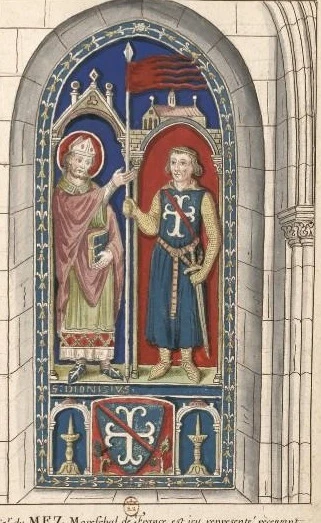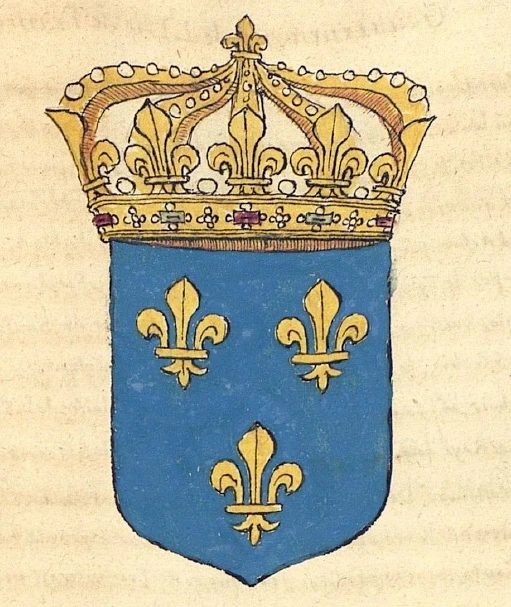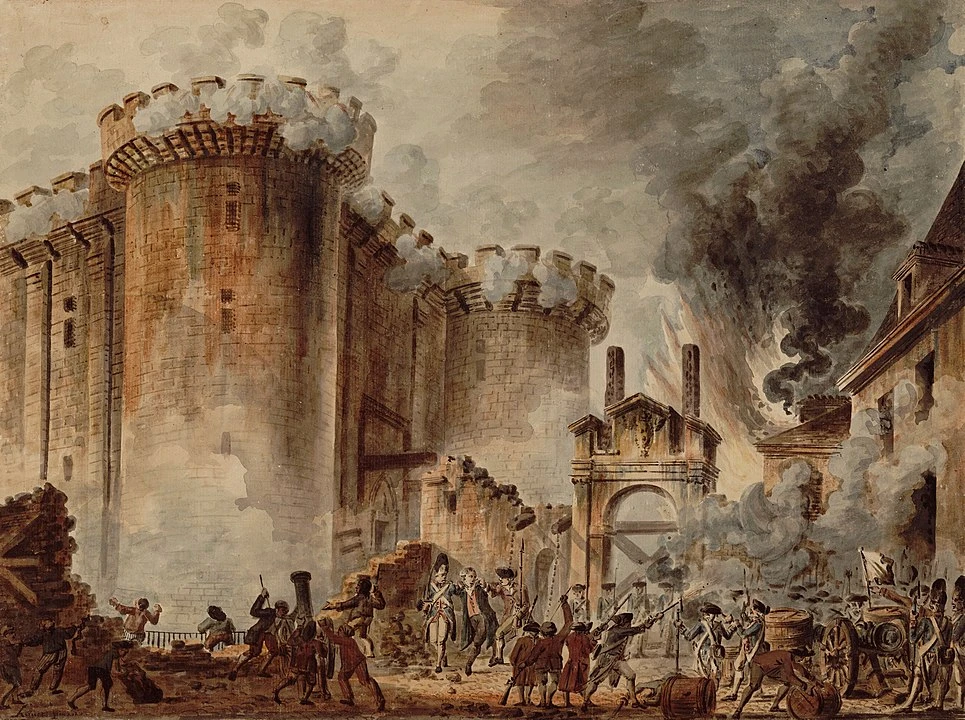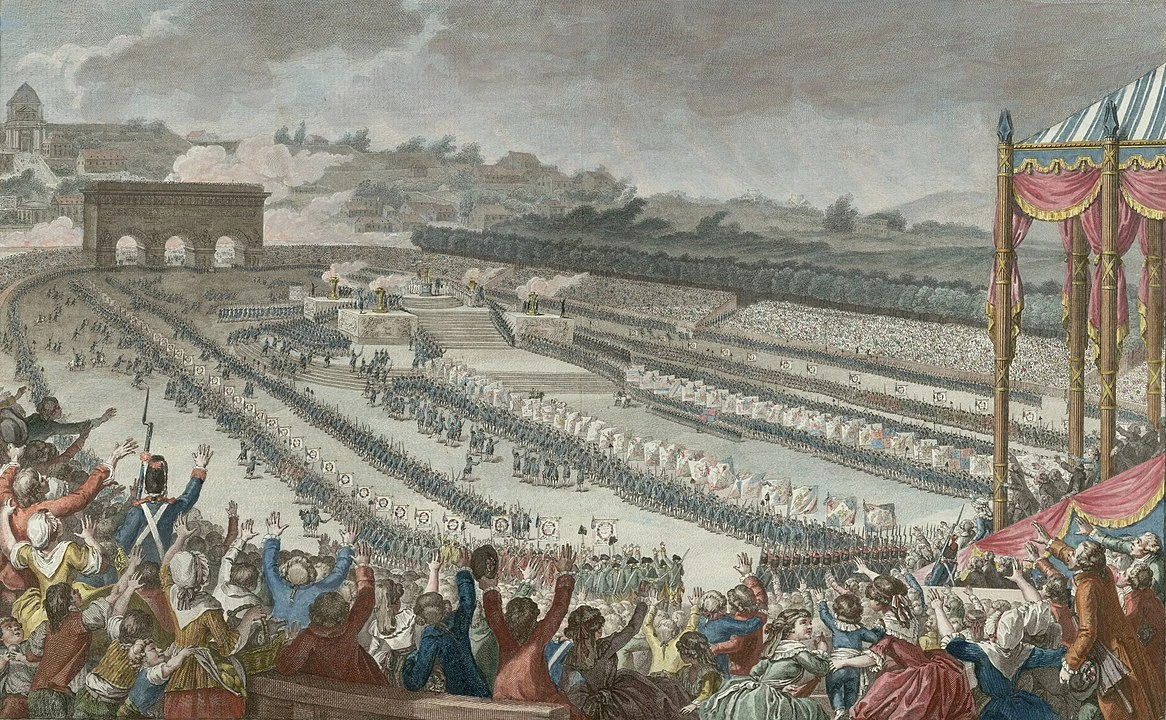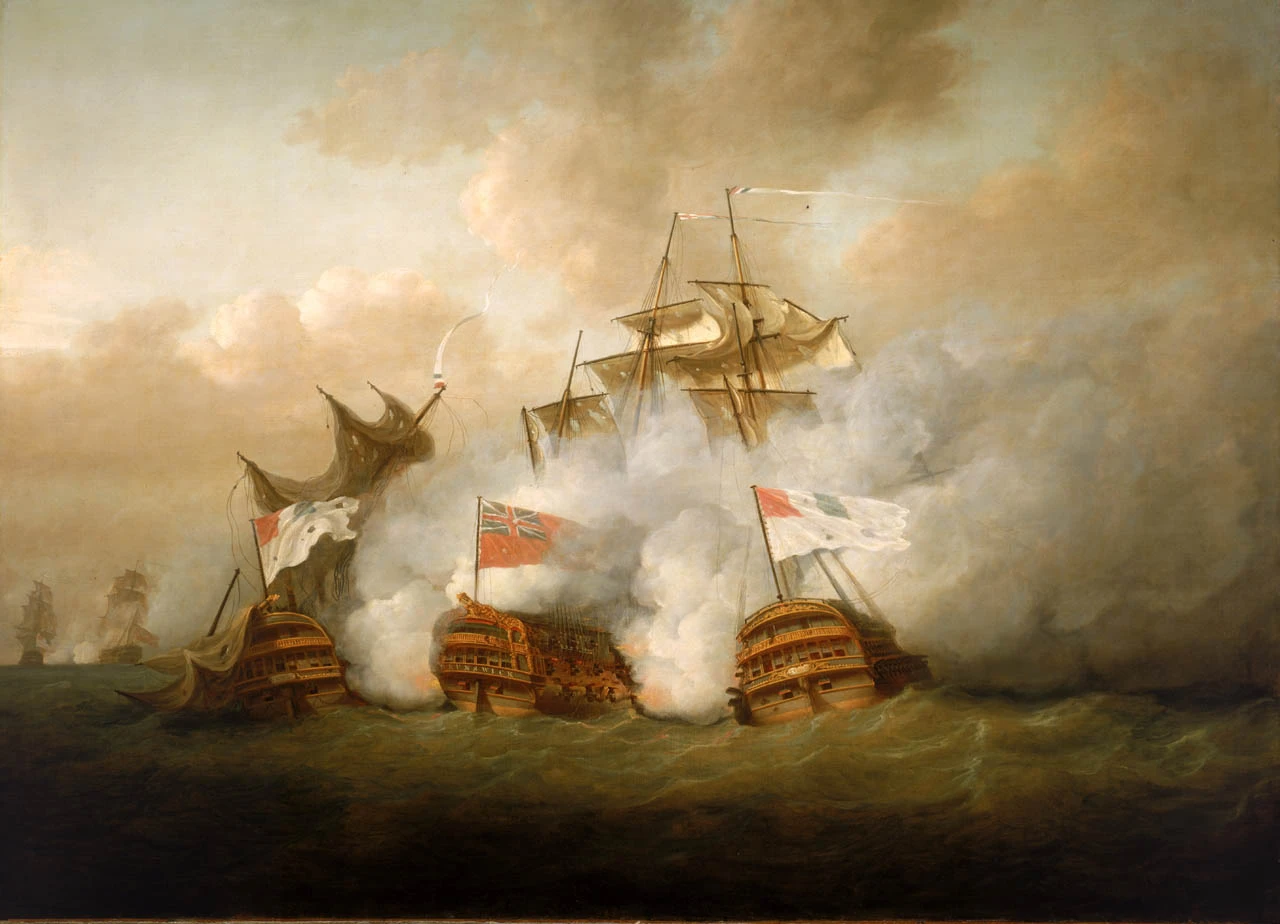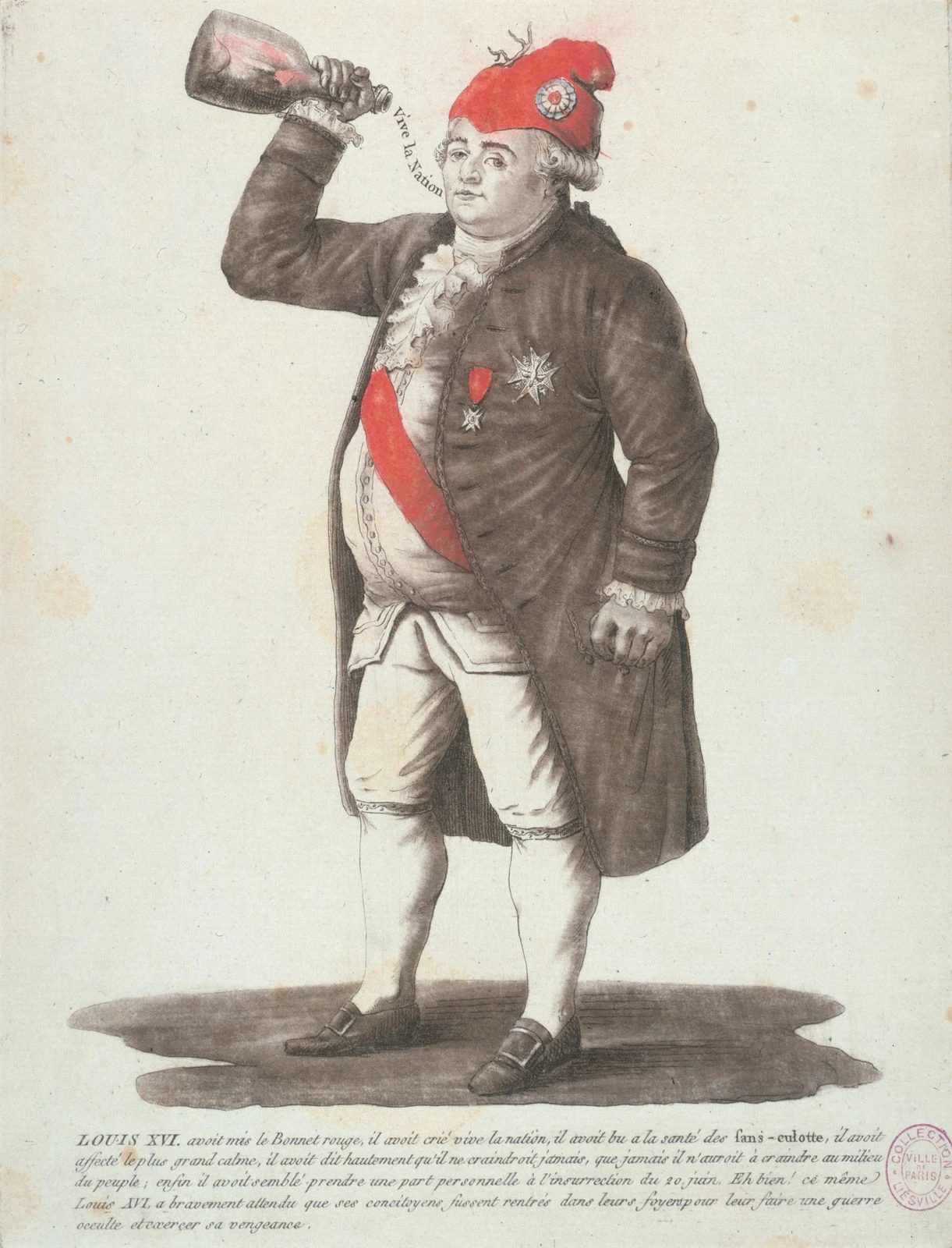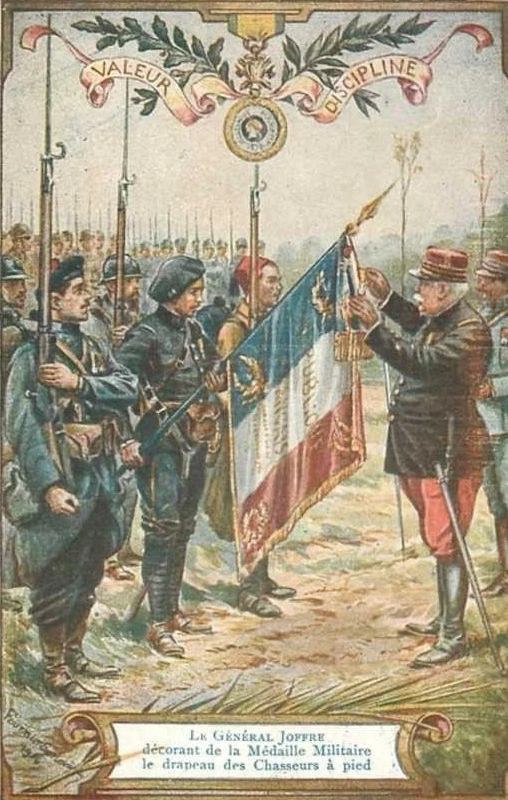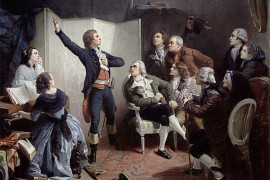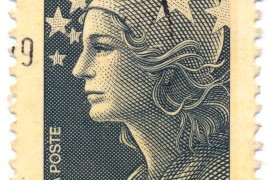The French flag, symbol of the Nation
The blue, the white... The french colors change for a long time
The idea of a national flag is an idea that was born with the concept of nation from the 18th century. Previously, the colors of the king are often confused with those of France. And these colors change. When the king goes to war, he brings out the "oriflamme de Saint Denis" from the royal abbey of Saint Denis near Paris, in red color.
Saint Denis handing over the oriflamme / By G.Garitan - Personal work, CC BY-SA 4.0, https://commons.wikimedia.org/w/index.php?curid=37212358
The king of France also has his own symbols, namely the golden fleur-de-lis on an azure background. They are represented on his coat of arms, on his coronation costume, on the livery of his guards. But white is also the emblem of the king at least since Henry IV. And the French ships display a white flag, color of the monarchy and color of France, for more than two centuries, until 1790. What will change everything is the French Revolution.
The golden fleur-de-lys on an azure background, coat of arms of the kings of France / Armorial said "de la Planche" 1669.
The French Revolution brings the three colors
In July 1789, the day after the storming of the Bastille, the people of Paris wore different cockades. Some wore a green cockade, others a white one, the French Guards, very popular since they were the first to enter the Bastille, wore a blue, white and red outfit. The colors most worn were blue and red, the traditional colors of the city of Paris. Some added white, symbol of the kingdom, as did La Fayette, very popular and leader of the National Guard, who wore a blue, white and red cockade. These three colors became the colors of the Revolution.
Prise de la Bastille le 14 juilllet 1789
First official mention of the three colors on March 20, 1790
A decree of the National Assembly, of March 20, 1790, consecrates for the first time the three colors since it is made obligation that "when the municipal officers will be in function, they will carry for distinctive mark a scarf to the three colors of the nation: blue, red and white". Note in passing that the order is not defined as we know it today. We also see them on July 14, 1790, the first national holiday in history, during the Federation Day which brings together delegates from all provinces in Paris to the king and queen for a huge celebration on the Champs de Mars at Paris.
La fête de la fédération, the first national holiday in French history / Vintage engraving.
And the creation of the first naval flag
On October 20, 1790, while the white flag was still the French maritime flag, Henri de Virieu proposed that the white of Henri IV be joined by a blue white red space so that "the color that was that of the plume of Henri IV was joined by that of the reconquered freedom". On October 24, the National Assembly validates a red white blue card on the white naval flags.
1st national flag blue white red carried by the Achilles (left) and "the People's avenger" (right) in this painting which represents the battle of Prairial An II against the H.M.S Brunswick / Painting by Nicolas Pocok (1740 - 1821) National Maritime Museeum).
1794: birth of the blue white and red flag.
When the French Revolution took a more eventful turn, it was these three colors that Louis XVI was forced to wear during the first capture of the Tuileries on June 17, 1792. The king was forced to wear the Phrygian cap, the revolutionary cap, with the blue, white and red cockade, and he had to drink "to the health of the People". Definitely, the three colors are the colors of the French Revolution. They will become those of the Republic.
1792 Louis XVI drinks to the health of the People and wears, well forced, the phrygian cap and the blue white red cockade.
In 1794, when France became a republic, the painter Jacques Louis DAVID (1748 - 1825) was asked to propose a new model of flag for the Navy. He proposed to start with the blue one. A few months later, the blue white and red flag was adopted as "the flag of the Nation". It will remain so during the Empire.
Chased by the returning monarchy.
Back in 1815, the monarchy immediately abolished the three colors and restored the white, color of the king. The military uniforms, often blue white red, are changed for white only. This lasted 15 years and ended with the Revolution of July 1830 which drove Charles X from power and installed Louis-Philippe, his cousin, in his place. Louis-Philippe, who had been involved in the early days of the French Revolution, took over the three colors in a bid to achieve national harmony. It is him who adds the rooster as emblem of the country. These three colors accompany France again. They almost disappeared in 1848.
Louis Philippe 1er, king of the French, by Winterhalter (1841).
Two choices that decided the colors of the national flag.

"Liberty guiding the People" / Par Delacroix (1830).
In 1848 the fall of the July monarchy, and while the Republic is restored, the question of the flag arises again. For some revolutionaries, as the blue, white and red flag had accompanied the July monarchy, it could not be emblematic of the brand new 2nd Republic. They wish to replace it by the red flag, more revolutionary. It is the poet Lamartine who wins the discussion and imposes the maintenance of the tricolor flag by saying "the tricolor flag made the tour of the world, with the name, the glory and the freedom of the Fatherland".
It was kept by Napoleon III who added the eagle as an imperial symbol. In 1873, two years after the terrible defeat of France against the new Germany, the question of the restoration of the monarchy was once again raised. The monarchist deputies had a majority in the National Assembly and the Crown was offered to the Count of Chambord, descendant of Louis XV. The Republic was about to be abolished when the Count of Chambord announced that he would not use the three colors as the national flag. It is against his convictions. If one maintains the three colors he refuses to be king. Impossible for the deputies of the time. The three colors are kept and the Republic, fresh of 2 years, is continued. The blue white and red flag has never ceased to accompany us.
In 1914, Joffre decorated the tricolor flag of a regiment.
The rules and customs for the French flag
It is officially the flag of the French Republic in the Constitution of the Fifth Republic. It is composed of 30% blue, 33% white and 37% red. The blue has evolved over time. Lighter during the French Revolution, darker during the Empire, lightened in 1974 by President Valery Giscard d'Estaing who found it too martial, it has now returned to the darker blue color. It appears on all public buildings, often alongside the European flag. It is placed near the President of the Republic during official speeches and since 2007 it is behind the perch of the National Assembly. Since 2003, contempt for the flag and the national anthem is punishable by law.
The national flag on the pediment of a French town hall / Image by JackieLou DL from Pixabay
The use of the three colors
Inherited from the French Revolution, the three colors are also still used by elected officials. They appear on the scarves of mayors (equipped with a gold tassel), deputy mayors (equipped with a silver tassel) but also deputies and senators. It is worn from the left shoulder to the right. Blue near the collar for local elected officials, red near the collar for national elected officials. Police commissioners and judicial police officers may also wear the scarf on certain occasions.
A quotation summarizes the history of this flag which has accompanied so many moments in the history of France. It is from Edmond Rostand (the author of Cyrano de Bergerac) and here it is:
Full of blood at the bottom and sky at the top,
Since the bottom dipped in a fertile horror,
And that the top bathed in the hopes of the world...
Unusual facts about the French flag
1. A model for other nations
After 1789, more than twenty countries adopted the principle of three vertical stripes inspired by the French flag: Italy, Romania, Chad, Ireland... This design symbolizes equality among citizens.
2. Napoleon I made it a sacred symbol
Emperor Napoleon had his regiments' flags blessed before each battle. Soldiers swore allegiance “to the flag and the Emperor.” The tricolor then became a sacred and patriotic object.
3. The flag of the Eiffel Tower
During the inauguration of the Eiffel Tower in 1889, a huge tricolor flag was hoisted at its summit. Gustave Eiffel, very proud of this gesture, saw it as “a visible sign of French genius.”
In 1944, during the Liberation of Paris, a 15-meter flag was once again hung there, becoming one of the symbols of a liberated France.
FAQ – The French flag explained to foreign visitors
Why is the French flag blue, white, and red?
Blue and red are the colors of Paris, and white was the color of the king. In 1789, these colors were combined to symbolize the union between the people and the monarchy.
When was the tricolor flag adopted?
It was created in 1794, during the French Revolution, and confirmed as a national symbol by the Republic in 1848.
What do the three vertical stripes represent?
They represent the French Nation: blue for liberty, white for unity, and red for courage and the blood shed for the homeland.
Has the French flag always been the same shade of blue?
No. The shade of blue has varied several times over the years: revolutionary, imperial, then modern since 2020.
Where can you see the French flag?
On all official buildings: town halls, schools, prefectures, embassies. It is also present at national ceremonies such as July 14.

